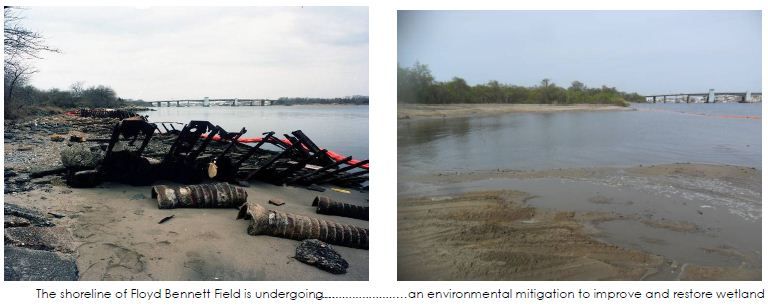Belt Parkway Construction Update: New Rockaway Exit Ramp Opens, Wetlands Mitigation Underway

A new Belt Parkway exit ramp will open tomorrow serving drivers at Rockaway Parkway (Exit 13). It’s the first stage of the new, permanent exit ramp. Upon full completion, the exit ramp will provide a wider lane, better riding surface and a safety shoulder for emergency stopping. The increased width will also provide better visibility while exiting the highway.
But that’s not the only update with the Belt Parkway reconstruction, which began at the end of 2009 and will ultimately see seven Southern Brooklyn Belt Parkway bridges replaced by 2016. While commuters have been banging their heads over the construction-spurred traffic problems, environmentalists may have reason to rejoice. As part of the project, the New York State Department of Environmental Conservation is mandating the contract recipient tidy up the shoreline and restore wetland habitats.
The cleanup portion of that task is just about done. Beginning in March 2011, workers cleared debris and other garbage from the north shore of Floyd Bennett Field. They’re finishing up planting mashland vegetation this month, and over the next several years are responsible for monitoring the area to ensure a steady return to a healthy habitat.
Here’s a quick description of the tidal wetlands restoration, from the Department of Transportation’s latest newsletter on the project:
The tidal wetlands along the Belt Parkway vary from open waters to coastal shoals and mudflats, intertidal marsh, and high marsh. All the tidal wetlands within and in close proximity to the project area have been largely disturbed within the past 60 years by channel dredging and spoils deposition, grading, and ongoing human activity, including boating, motor vehicle use, illegal dumping and littering. Though stressed, the tidal wetland systems in the project vicinity still support a variety of wildlife including birds, fish, and benthicin vertebrates.
The overall goal of the mitigation project is to restore selected areas of Floyd Bennett shoreline with productive habitats, including unvegated intertidal areas, vegetated intertidal areas restored with naturally occurring Spartina marsh, and high marsh habitats. A significant portion of the area involves the removal of approximately 20,000 cubic yards of previously filled areas and the restoration of the areas to productive vegetated and unvegetated wetland resources.
Overall, approximately 2.3 acres of land at Floyd Bennett Field will be cleaned of rubbish and debris and converted to wetland area.
As for the highway itself, Councilman Lew Fidler – whose district covers most of the construction area – recently told attendees at the Madison-Marine-Homecrest Civic Association that the work is actually progressing ahead of schedule. The project is part of a long-term renovation plan for the Belt Parkway that seeks to modernize the highway, which was built more than 70 years ago, and has since seen a stark increase of traffic with the establishment of John F. Kennedy airport and the rise of suburbs after World War II. The first stage of the seven bridges project is to replace the Fresh Creek, Rockaway Parkway, and Paerdegat Basin Bridges. The other structures targeted by the project include the Nostrand Avenue Bridge, Gerritsen Inlet Bridge, Mill Basin Bridge, and Bay Ridge Avenue Bridge.




